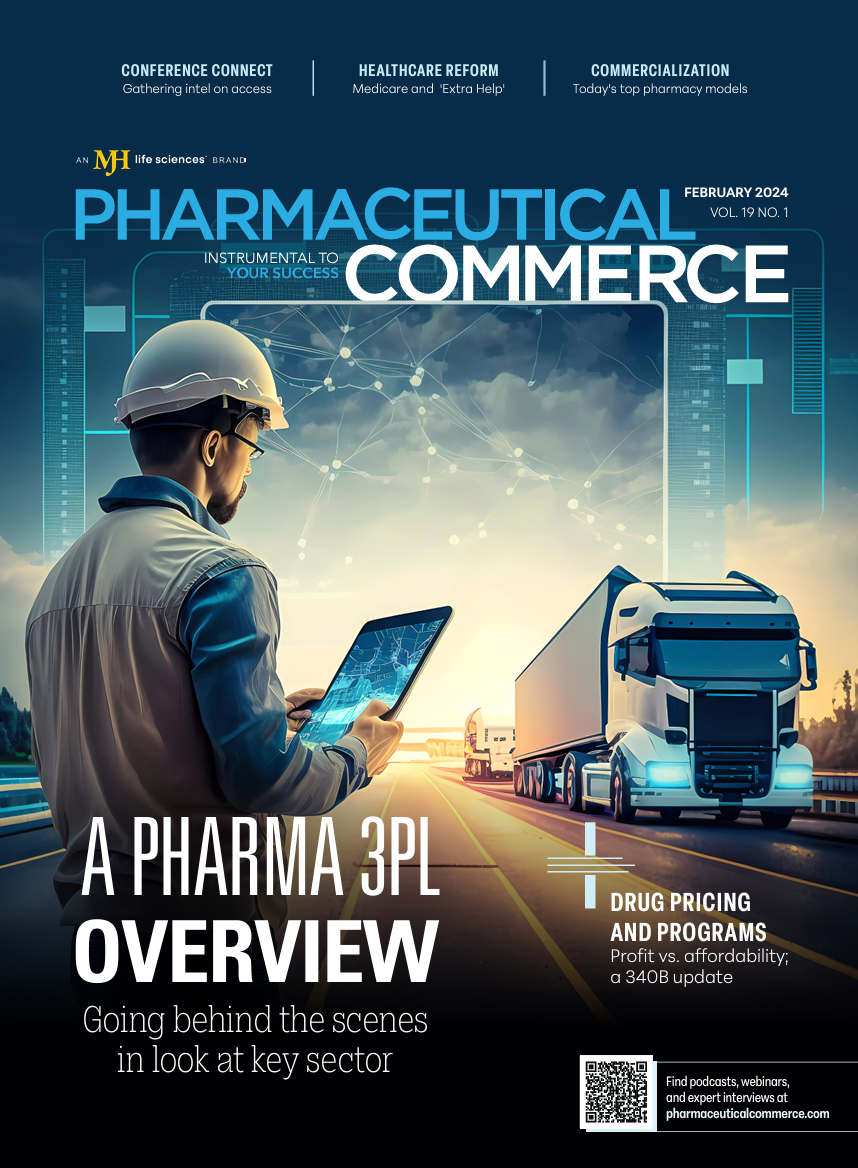Peeking Behind the Curtain: The Current State of Pharma 3PLs and Future Outlook
Leading experts in the sector explore the value of third-party logistics providers when it comes to fortifying pharmaceutical supply chains.
Third-party logistics (3PL) providers are often called upon by pharmaceutical manufacturers to help address the challenges surrounding the movement and distribution of medicines; their importance in helping to simplify the pharma supply chain does not go unnoticed. Pharmaceutical Commerce set out to examine the most relevant trends affecting pharma 3PLs heading into 2024, and explores their impact for the future, specifically over the course of the next decade.
To that end, in separate conversations, we spoke with a selection of key opinion leaders representing various 3PLs that work with biopharma manufacturers.
Those interviewed include:
- Jim Saponaro, President, Life Sciences, DHL Supply Chain
- Danny Williams, President, Channel Management, EVERSANA
- Kevin Kissling, VP & General Manager, LogiCare3PL
- Chris Dillon, General Manager, Knipper 3PL, KnippeRx
This following roundtable-style discussion has been edited for length and clarity.

Q: Pharma Commerce: Could you provide a general overview of how the 3PL process works?
Jim Saponaro: In the complex world of pharmaceuticals and healthcare, manufacturers often turn to logistics partners to streamline their supply chain. A strong 3PL partner offers best-in-class service in distribution, managed transportation, and value-added services. A manufacturer leverages the infrastructure, knowledge, and capital of the 3PL so that the manufacturer can focus on its own core competency of discovering drugs, designing medical devices, and developing new consumer health products for the global population.
Danny Williams: 3PL has been part of the pharmaceutical industry for decades. Since its inception, the pharmaceutical 3PL space has evolved with technology, integration points, and services to meet the growing requirements for products supported and the changing landscape of distribution channels available to manufacturers.
At the most basic level, a pharmaceutical 3PL provider works on behalf of a manufacturer to manage the storage (warehousing), order processing, distribution, and logistics (transportation) of pharmaceutical products. They can perform a myriad of services, including order to cash and revenue management services, quality management services, and both export and import activities to support every stage of the product movement. Often, 3PL providers will manage the product logistics post-manufacturing, from the dock of the manufacturing site to when it arrives in a port, to a truck to the distribution center, and then ultimately to a hospital, clinic, pharmacy, and wholesaler or distributor. Simply stated, the goal of the 3PL is to make the complexities of moving, storing, and distributing the product and shipping to the final mile seamless for the manufacturer, with the ultimate goal of ensuring the patient receives his or her needed medication.
Q: What factors should manufacturers consider when selecting a 3PL, and what array of services should a quality 3PL provide?
Chris Dillon: It’s important to choose a 3PL that provides all the necessary services to support the specific distribution model of the manufacturer. This is accomplished by aligning and often exceeding compliance with regulatory authorities, operational automation, in-depth reporting technology, scalability, and a personal consultative approach for the manufacturer partner. The 3PL should be a true partner with diverse experience that can assist the manufacturer in achieving their goals. This begins with an implementation and client management team with industry experience that not only understands their client’s business, but one that can provide value through recommendations that enhance their client’s business. There are seven critical competencies to consider when evaluating a 3PL:
- Accuracy: Be assured that your 3PL is highly focused on accuracy and efficiency in order-to-cash and distribution operations. Utilizing state-of-the-art systems, exceptional training, and rigorous quality standards, a competent 3PL will perform at a high level from implementation through the life cycle of the manufacturer’s program.
- Client focus: When working with your 3PL, you should expect uninhibited access to your 3PL client management and the 3PL leadership team. Never should you ever feel like your program is secondary to another manufacturer’s program. Conversely, you should expect your 3PL to treat you as a priority and have a committed team that responds immediately, even when information or solutions to an issue are still in the works.
- Scalability: Your 3PL must have the capacity, technology, and support team to adapt to your growing business needs. When you conduct site visits, look for open space in the facility. If none is visible, ask to see it. If there is no open space, there is a chance that the capacity to manage your business as it grows will be limited.
- Data management and reporting: You should expect your data to be accurate and available in real time. Additionally, your reporting should be customized for your specific business. Your business differs from others, and your reporting should reflect what matters to you. Finally, your data should be easy to use and sharable on any device.
- Flexibility: Your 3PL must be adaptable, flexible, and willing to provide solutions that can be built to your specific needs without compromising rigorous adherence to regulatory requirements.
- Regulatory compliance: Your 3PL should have a long-term and consistent, positive track record with regulatory and governing bodies and should continuously monitor and update processes and procedures based on new laws, regulations, and requirements.
- Drug Supply Chain Security Act (DSCSA) serialization and UDI rule readiness: The FDA requires identification and tracking of prescription drug products and medical devices from the point of manufacture through the healthcare supply chain. Your 3PL should demonstrate compliance with both the DSCSA and unique device identification system (UDI Rule) requirements (specific to your program). It must also be equipped to manage the possible exceptions and procedures to resolve them.
Kevin Kissling: When manufacturers consider selecting a 3PL, two main factors come to mind. First is quality. It is important to carefully assess the quality systems and processes of a 3PL, and to ensure they are committed to quality and cGMP (current good manufacturing practice) compliance. The second factor is relationship and cultural alignment. Manufacturers spend a significant amount of time with their 3PL partner; therefore, building and maintaining a strong relationship with a partner that has a similar outlook on corporate culture and goals is essential to successful outcomes.
In addition, 3PLs should have a flexible consultative approach that allows them to consistently execute at a high level, deliver results, and foster trust. A good 3PL partner should provide its customers with industry-leading technology and services that cultivates the pharma company’s channel strategy. Services such as qualified cold chain storage and packaging, repackaging/relabeling, serialization, customer care, and the ability to obtain and/or maintain state board-of-pharmacy licenses on behalf of the pharmaceutical company are just a few examples of services offered by 3PL companies that add value to their customers.
Image Credit: Siripimon2525.com/stock.adobe.com

Q: What valuable lessons did you learn during the COVID-19 pandemic that have helped improve efficiencies?
Williams: COVID-19 was hard for everyone in the industry, but from our 3PL perspective, the pandemic reinforced just how important the work we do is. Never before had there been so much responsibility for companies to distribute therapies or test kits for the public good, and we were proud to play a role during the pandemic.
COVID required us to reimagine some of our technology and look to make our processes even more efficient. COVID learnings identified that end-to-end supply chain review with proactive assessment of the stability of the supply chain is paramount to the ongoing success of manufacturers and continuity of products to customers and patients.
Saponaro: The pandemic highlighted challenges in just-in-time healthcare logistics. Global chains choked, revealing nearshoring and diversified sourcing as the best options going forward. The use of technology made a massive leap with many solutions for warehouse automation, such as automated guided vehicles (AGVs) and autonomous mobile robots (AMRs) coming online as a solution for the newly created labor challenges. Sustainability also became a vital thread, rewriting packaging, transport, and warehousing with an eye on resilience. We learned the hard way, but the future of healthcare logistics is more responsive, more agile, and better prepared to serve the needs of patients, regardless of future challenges.
Kissling: I learned several valuable lessons during the COVID-19 pandemic that remain with me and continue to improve efficiencies. One key lesson was the realization that extensive travel isn’t always necessary. While face-to-face meetings hold significant value, the pandemic highlighted the effectiveness of teleconferencing tools, leading to a more balanced approach to in-person meetings. Another lesson involved the importance of risk mitigation plans. The pandemic highlighted the need to have comprehensive strategies in place to ensure adequate staffing across all business functions. It also emphasized the critical role of a well-managed supply chain and the need to secure essential materials, such as packaging materials, in order to maintain seamless operations.
Dillon: A detailed disaster recovery plan where the 3PL addresses plans of action for weather-related emergencies, social or political unrest, pandemics, and a host of other threats should be in place and readily viewable by the manufacturer partner. While many non-distribution personnel shifted to some type of remote work during the height of the pandemic, the most efficient work in 3PL distribution and order-to-cash operations happens when people are together, on-site. The training, work quality, and collaboration ability are better and more efficient.
When evaluating a 3PL, ask if the customer operations and client management team can physically interact and discuss business operations in person with the distribution operations and quality teams. This cuts down on email traffic, missed priorities, and mistaken tone or urgency for certain items, leading to better overall quality and responsiveness for the manufacturer client.
Q: With 2024 underway, which trends affecting the pharma industry will 3PLs be on the lookout for?
Saponaro: We believe that many pharmaceutical companies are turning to nearshoring for more throughput, but this has introduced a new challenge for manufacturers and contract manufacturing organizations who now need even more warehousing to create drugs and store finished product. As Rx moves to more discoveries to treat specialized population sets, we have seen the need to have more inventory placed in greater proximity to patient populations. This has driven a unique growth in multi-client facilities.
Dillon: Retail drug chains are experiencing a significant decrease in on-site consumer/patient patronage, which consequently negatively affects the wholesale supplier. In response to the decrease in store traffic, many retail pharmacies are moving away from branded drugs and are transitioning from insurance to cash-pay models. As a result, the pharmaceutical industry will continue to see an increase in direct from-manufacturer-to-patient and direct-from-manufacturer-to-point-of-care service models. 3PLs with the ability to handle this transition will be well-prepared for the future state of branded drugs. Finally, across the industry, from medical devices to prescription drugs, serialization and product tracing will continue to make healthcare safer for patients. Competent 3PLs have systems in place to handle the tracing of both drug and medical device products.
Williams: Consolidation of vendors by the pharmaceutical industry is a trend we see playing out in 2024, with companies reducing the number of vendors for various aspects of the commercialization process and instead, turning to fewer partners who can do more. Aside from consolidation, supply chain disruptions [i.e., climate change impacting the lock’s water shortage in the Panama Canal and geopolitical conflicts impacting trade routes like the Suez Canal] will continue in 2024 and beyond. We are poised to assist and partner in mitigating these end-to-end disruptions through multiple service offerings and with deep partnerships that are focused exclusively on the pharmaceutical industry.
Kissling: This industry is rapidly changing. High distribution service fees are forcing manufacturers, especially small manufacturers with "specialty lite" price points ($8,000-$20,000), to look at direct distribution models. A focus on drug pricing will keep manufacturers focused on cost. 3PLs that can offer a comprehensive set of services at competitive price points will help manufacturers win. Cell and gene technology and personalized medicine are areas that 3PLs will look to play a more extensive role, as they involve very complex cold chain requirements and innovative pricing mechanisms.
Q: How much of an impact do you anticipate 3PLs having over the course of the next decade?
Dillon: The focus of the healthcare supply chain is to get therapies to patients who need them and conduct business in a way that is compliant and ethical while showing fiduciary responsibility that increases gross-to-net margins for the companies and investors who support them. 3PLs are an essential piece of this puzzle and provide cost-effective, compliant, efficient, and safe avenues to get products to the patients who need them. Over the next 10 years, manufacturers will continue to see that value and will continue to trust the right 3PLs for their specific program requirements.
Saponaro: The need for 3PLs will only strengthen over the next decade as supply chains become even more complex across extended geographies and channels. Additionally, innovation and generative AI will accelerate the digitalization campaign at warp speed that manufacturers simply cannot keep pace with but 3PLs are better suited to invest in. Those manufacturers that partner with a world-class supply chain partner will find themselves with unlocked capital, freedom to scale and flex as needed in a very dynamic marketplace, and ultimately gain a competitive advantage over their peers due to the elasticity and resiliency they have built with their 3PL partner for life.
Williams: The need for 3PLs will continue to evolve as the needs of the pharmaceutical industry grow. I expect the continued push for higher levels of performance, effectiveness, and efficiency in the supply chain will be aided by the accelerating use of AI and autonomous mobile robots. It’s important to note that the number of products being developed and in need of a 3PL provider is not slowing, and providers that can deliver the highest levels of quality, understand manufacturer needs, and have a proven track record of delivering will be in a great position for future growth.
Kissling: 3PLs will have a significant impact on the pharma manufacturers and the overall channel in the years ahead. Manufacturers will continue to use 3PLs—especially emerging manufacturers due to the benefits and expertise that 3PLs bring to the table. As the industry continues to evolve, 3PLs service providers will player an even deeper role within the supply chain, adding services and support manufacturers need to succeed.
